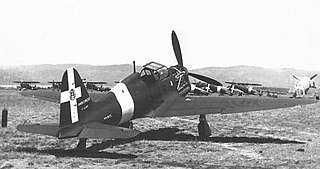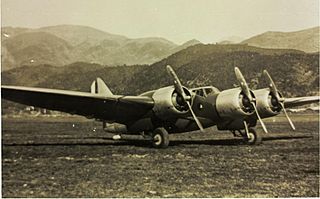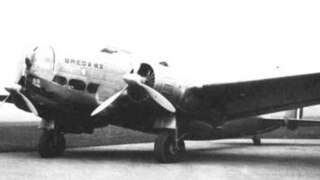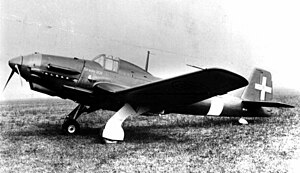
The Savoia-Marchetti SM.81 Pipistrello was the first three-engine bomber/transport aircraft serving in the Italian Regia Aeronautica. When it appeared in 1935, it represented a real step ahead in Italian military aviation: it was fast, well armed and had a long range. It proved effective during the war with Ethiopia and the Spanish Civil War. Despite being too slow to remain competitive as a bomber in the later years of World War II, it was one of the most flexible, reliable and important aircraft of the Regia Aeronautica from 1935 to 1944, and adapted to second-line duties in a wide range of tasks.

The Breda Ba.88 Lince ("Lynx") was a ground-attack aircraft used by the Italian Regia Aeronautica during World War II. Its streamlined design and retractable undercarriage were advanced for the time, and after its debut in 1937 the aircraft established several world speed records. However, when military equipment was installed on production examples, problems of instability developed and the aeroplane's general performance deteriorated. Eventually its operational career was cut short, and the remaining Ba.88 airframes were used as fixed installations on airfields to mislead enemy reconnaissance. It represented, perhaps, the most remarkable failure of any operational aircraft to see service in World War II.

The Breda Ba.65 was an Italian all-metal single-engine, low-wing monoplane used by Aviazione Legionaria during the Spanish Civil War and Regia Aeronautica in the first half of World War II. It was the only Italian ground-attack aircraft that saw active service in this role. It saw service almost exclusively in the North African and Middle-Eastern theatre. In addition to more than 150 aircraft operated by the Italian forces, a total of 55 were exported and used by the air forces of Iraq, Chile and Portugal.

The AUT.18 was a prototype fighter aircraft developed in Italy by Aeronautica Umbra shortly before the outbreak of World War II. It was designed in 1934 by Felice Trojani, who at that time was collaborating with Umberto Nobile on the Arctic flights of the airships Norge and Italia. The aircraft's designation came from initials of the manufacturer, the surname of the designer, and the aircraft's wing area, the sole prototype receiving the serial no. M.M.363.

The Fiat CR.25 was an Italian twin-engine reconnaissance-fighter aircraft which served in small numbers for the Regia Aeronautica during World War II.

The Breda Ba.64 was an Italian single-engine ground-attack aircraft used by the Regia Aeronautica during the 1930s.

The Ambrosini SAI.207 was a light fighter interceptor built entirely from wood and developed in Italy during World War II. Powered by a single 750 hp Isotta Fraschini Delta, the SAI.207 enjoyed limited success during evaluation of the 12 pre-production aircraft.

The Caproni Ca.314 was an Italian twin-engine attack/torpedo bomber aircraft, used in World War II.

The Savoia-Marchetti SM.85 was an Italian monoplane dive bomber and ground-attack aircraft that served in small numbers in the Regia Aeronautica at the beginning of World War II. They were soon replaced in service by the Junkers Ju 87.

The Reggiane Re.2002 Ariete ("Ram") was an Italian fighter-bomber developed during World War II. The aircraft was a further development of the Re.2000, with some of the modifications that already had been introduced in the Re.2001. The aircraft was mainly used by the Regia Aeronautica, but it also saw limited use with the German Luftwaffe, who used it against the French resistance.

The CRDA CANT Z.1018 Leone (Lion) was an Italian medium bomber of the 1940s.
The Savoia-Marchetti SM.88, was an Italian twin-engined, three-seat, heavy fighter prototype of World War II, featuring a twin-boom structure, and powered by German Daimler-Benz DB 601 engines.

The Savoia-Marchetti SM.91 was a two-seat, twin-engined, Italian heavy fighter prototype, designed to compete in a 1942 revision to a long-range fighter-bomber contract offered by the Regia Aeronautica to Italian aircraft companies in 1938. The original 1938 specification yielded the Savoia-Marchetti SM.88, which the SM.91 was largely based on.

The IMAM Ro.57 was an Italian twin-engined, single-seat monoplane fighter of the Regia Aeronautica. Based on a 1939 design by Giovanni Galasso the aircraft did not enter production until 1943.

The Caproni Ca.355 Tuffo was a low-wing single-engine dive bomber, designed and built by the Italian Caproni company in 1941, which never proceeded beyond a single prototype. Derived from Ca.335 Mistral, the Ca.355 was proposed to equip the Regia Aeronautica, but it was found to offer little advantage over the German Junkers Ju 87 "Stuka" and the project was abandoned.

The Caproni Vizzola F.4 was an Italian fighter aircraft prototype that was designed in 1937 and built from 1939. It was a single-seat, low-wing cantilever monoplane with retractable landing gear.

The Piaggio P.16 was an Italian heavy bomber designed and built by Piaggio for the Regia Aeronautica.

The Breda Ba.82 was an Italian medium bomber prototype of the late 1930s; it was designed and built by the Breda company.
The Macchi M.C.77 was a reconnaissance bomber flying boat built by Macchi in the thirties and remained at the prototype stage.
The Caproni Ca.142 was a three-engined multirole aircraft built by Caproni in the mid-1930s.

















